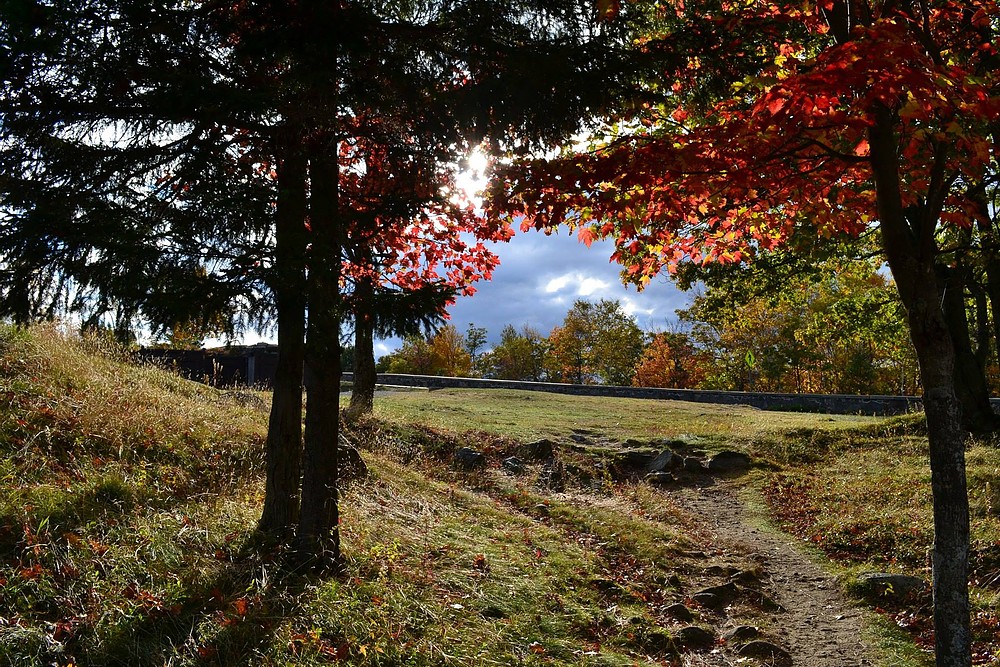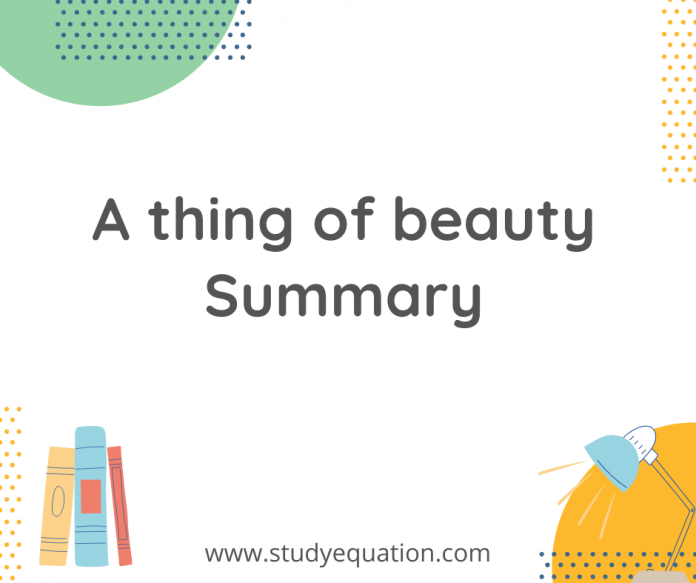A Thing of Beauty is a joy forever – This has been reiterated throughout the poem through poetic devices. It is followed by question answers and mcqs. This poem is taken from the poem by the renowned author John Keats, “Endymion-a poetic romance.” The poet claims that a beautiful thing is a source of everlasting pleasure. It has infinite beauty that never fades away. A beautiful thing is like a shady shelter that gives us a sleep full of sweet dreams, good health and comfort.
Table of Contents
Summary – A thing of beauty ( Summary of a thing of beauty )
Summary of a thing of beauty : Our connection to earthly objects is like a wreath of roses. They are traps which bind us to materialistic objects and take us away from eternal happiness. The world is full of hate, envy, and negativity. The doom and sorrow caused by this negativity, according to the author, melts away with the optimistic vibes of the lovely things around us.

The poet lists some of the lovely things surrounding us. He says that God’s numerous creations, such as the sun that gives us energy, the beauty of the moon, the trees that give us shade, are the natural beauties around us. The different animals, such as the sheep surrounding us, make our world lively. Beautiful flowers such as daffodils make the world green and vibrant. In the hot summer season, the flowing streams of water cool and refresh us.
About the Author Of “A Thing of Beauty” – John Keats
John Keats is a well-known personality already and people have been interested in knowing about him. Some want to know about his personal life like his family, his net worth, and his income, and some want to know about his professional life. Here “Studyequation” has come out with a whole bunch of information.
John Keats’s Birthday Date is 31 October 1795 and his birthplace is Moorgate, London, United Kingdom. He was a famous and professional English romantic poet. His Father Name, His Mother’s Name, Relationship, Girlfriend’s name, name all Details are given below.
Poetic devices – A Thing of Beauty Poetic Devices
Paragraph 1
A thing of beauty is a joy forever
Its loveliness increases, it will never
Pass into nothingness; but will keep
A bower quiet for us, and aSLEEP
Full of sweet dreams, and health, and quiet breathing.
- Rhyme scheme: aabbc (forever, never, keep, sleep, breathing)
- Alliteration: Use of consonant sound at the start of two words which are close in series (Sleep-Sweet)
- Metaphor: bower Quiet (calmness of the bower is compared to the calming effect of a beautiful thing)
Paragraph 2
Therefore, on every morrow, are we wreathing
A flowery band to bind us to the earth,
Spite of despondence, of the inhuman dearth
Of noble natures, of the gloomy days,
Of all the unhealthy and o’er-darkened ways
Made for our searching: yes, in spite of all,
Some shape of beauty moves away the pall
From our dark spirits.
- Anaphora: Use of same word in two consecutive lines (of noble natures- Of all the unhealthy)
- Alliteration: Use of consonant sound at the start of two words which are close in series (‘b’ in Band Bind, ‘n’ in Noble nature, ‘s’ in some shape).
- Metaphor: wreathing a flowery band (the beautiful things of our life bind us to the earth)
- Imagery: creating a sensory effect of beautiful things lined up in a string (A flowery band to bind us)
- Inversion: normal order of words is reversed (Are we wreathing a flowery band)
Paragraph 3
Such the sun, the moon,
Trees old, and young, sprouting a shady boon
For simple sheep; and such are daffodils
With the green world they live in; and clear rills
That for themselves a cooling covert make
‘Gainst the hot season; the mid forest brake
- Alliteration: Use of consonant sound at the start of two words which are close in series (‘s’ in Sprouting Shady, Simple sheep, ‘c’ in cooling covert)
- Imagery: Trees giving shade (sprouting shady boon), growing process of daffodils (daffodils with the green world they live in), Clean River streams (Clear rills)
- Antithesis: opposite words placed together (old and young)
Paragraph 4
Rich with a sprinkling of fair musk-rose blooms;
And such too is the grandeur of the dooms
We have imagined for the mighty dead;
All lovely tales that we have heard or read;
An endless fountain of immortal drink,
Pouring unto us from the heaven’s brink
- Alliteration: Use of consonant sound at the start of two words which are close in series (‘h’ in have heard)
- Metaphor: Immortal drinks (beautiful objects of nature are forever like a never-ending portion of a drink)
- Rhyme: Rhyme scheme is used in every stanza of the poem (forever; never, keep; sleep, dead; read etc.)
- Imagery: Bushes full of musk roses (sprinkling of fair musk rose blooms), books describing valor of fighters (grandeur-. mighty dead), God providing us with best things (pouring from the heaven’s brink)

Questions and Answers – A thing of beauty
Q1. List the things of beauty mentioned in the poem.
Q2. List the things that cause suffering and pain.
Q3. What does the line, ‘Therefore are we wreathing a flowery band to bind us to earth’ suggest to you?
Short answers – A thing of beauty
Q4. What makes human beings love life in spite of troubles and suffering?
Q5. Why is ‘grandeur’ associated with the ‘mighty dead’?
Q6. Do we experience things of beauty only for short moments or do they make a lasting impression on us?
Q7. What image does the poet use to describe the beautiful bounty of the earth?
Q8. How can mighty dead be things of beauty?
Q9. The true beauty central idea
Q10. Poems about beauty of nature
Each poem employs this theme in a distinctive manner, regardless of whether nature is a metaphor or the focus of a world that is becoming increasingly polluted.
1. ” The Road Not Taken” by Robert Frost
This is among Robert Frost’s most well-known poems that inspires all people. He describes his travels along a path and the time when he needed to choose his path upon encountering a fork in the road. “Two roads diverged in a wood, and I–/I took the one less traveled by/And that has made all the difference,” the poet writes. This poem is often used to inspire you to do something daring or make an unusual choice, as it demonstrates the consequences of choosing “The Road Not Taken.”
2. ” The Rose That Grew From Concrete” by Tupac Shakur
The hip music legend Tupac Shakur wrote of his struggle to overcome in this poem, which is a celebration of the rose that was cultivated from concrete. The average person doesn’t think much can be able to grow out of concrete, except for grass , weeds, and even weeds. The poet Tupac takes this idea and examines what it means for the rose that blooms in the first place, the natural laws it violates and how people react. “Long live the rose that grew from concrete when no one else ever cared,” Tupac wrote.
3. ” The Tree Agreement” by Elise Paschen
This poem is an excellent illustration of the significance and beauty in ordinary moments, like when you argue with a neighbor over whether to cut down a tree, or whether to do it. “The Tree Agreement “The Tree Agreement,” Elise Paschen describes this conflict and the value she sees in the tree and her determination to preserve the tree. In using a brutal language to describe the removal of the tree, and using dark descriptions of neighbors, she demonstrates that she is awed by the tree, an amazing natural element that is growing within an urban area.
4. ” The Sun” by Dan Chiasson
This poem celebrates the force of the sun, and compares it to god. Dan Chiasson writes that the sun is the only thing that connects us all. The sun is the master of darkness, since the sun is “in charge of the imagination.” The sun is the one who makes stars disappear, however it makes stars appear everywhere.
5. ” Water” by Ralph Waldo Emerson
Similar to the poem before This poem focuses on the extraordinary power of water as well as its capacity to create and destroy. “Water,” however, is a perfect illustration of the art of not using one word added. In only 51 phrases, Ralph Waldo Emerson writes the way water can “doubleth joy” or just as easily “elegantly destroy.”
6. ” Caged Bird” by Maya Angelou
Don’t forget about animals , and their symbolism and power in poetry! In this famous poem Maya Angelou writes about a bird that is liberated and one that is confined as a metaphor to represent the limitations of racism. Angelou describes the bird that has wings that fly floating, hovers, as well as “dares to claim the sky.” She also describes the bird in a cage with wings clipped and feet that are tied “on the grave of dreams.” Although the bird isn’t equipped with wings — a traditional symbol of freedom — she understands what it is doing rather than fly.
7. ” There Will Come Soft Rains” by Sara Teasdale
In 1918, during the influenza epidemic in 1918 and World War I, Sara Teasdale looks to nature to offer some hope. “There will come soft rains and the smell of the ground/And swallows circling with their shimmering sound,” she writes. In spite of the despair and death of the time, Teasdale turns to the inevitable beauty of nature to provide hope for a peaceful healthy and happy world.
Q11. When you are old summary
Also Read: My Mother at Sixty-six
Read the stanzas and answer the questions
1. A thing of beauty is a joy forever Its loveliness increases, it will never Pass into nothingness; but will keep A bower quiet for us, and a sleep
Full of sweet dreams, and health, and quiet breathing.
Questions
(a)Name the poem and the poet of these lines.
(b)How is a thing of beauty a joy forever?
(c)What do you understand by a ‘bower’s
(d)What kind of sleep does it provide?
Answers:
(а)The poem is A Thing of Beauty. The poet is John Keats.
(b)A thing of beauty is the source of constant joy. Its beauty goes on increasing. It will never pass into nothingness.
(c)A bower is a pleasant place in the shade under a tree. It protects people/animals from the hot rays of the sun.
(d)It provides us with a sound sleep, full of sweet dreams, health and peaceful breathing.
2. Therefore, every morrow, are we wreathing A flowery band to bind us to the earth,
Spite of despondence, of the inhuman dearth of noble natures, of the gloomy days,
Of all the unhealthy and over-darken ways
Made for our searching: yes, in spite of all,
Questions [All India 2014]
(a)Name the poem and the poet.
(b)Why are we despondent?
(c)What removes the pal from our dark spirits?
(d) What are we doing every day?
Answers:
(а)The poet is John Keats. The poem is A Thing of Beauty.
(b)We possess the evil qualities of malice and disappointment. We suffer from a lack of noble qualities. That is why we feel despondent.
(c) Some beautiful shapes or a thing of beauty removes the pall of sadness from our hearts or spirits.
(d) We are weaving a flowery wreath to bind us to the beauties of the earth.
Read the stanzas and answer the questions
3. Some shape of beauty moves away the pall from our dark spirits. Such the sun, the moon,
Trees old and young, sprouting a shady boon for simple sheep; and such are daffodils
With the green world they live in; and clear rills That for themselves a cooling covert make ‘Gains the hot season; the mid forest brake,
Rich with a sprinkling of fair musk-rose blooms;
Questions
(а)What removes the pall from our dark spirits?
(b)What sprouts a shady boon for sheep and how?
(c) How do ‘daffodils’ and ‘rills’ enrich the environment?
(d) What makes the mid-forest brake rich?
Answers:
(a)Some beautiful shape or a thing of beauty removes the pall of sadness from our hearts or spirits.
(b) Old and young trees sprout to make a green covering. It proves a blessing for simple sheep as it serves them as a shelter.
(c)Daffodils bloom among the green surroundings. The rills or small streams of clear water make a cooling shelter for themselves against the hot season.
(d)The mid forest brake is made rich by the blooming of beautiful musk-roses.
(e)(i) pall, (ii) boon, (iii) rills, (iv) covert.
4. And such too is the grandeur of the dooms
We have imagined the mighty dead;
lovely tales that we have heard or read;
An endless fountain of immortal drink,
Pouring unto us from heaven’s brink
Questions [Delhi 2014]
(a)Name the poem and the poet of these lines.
(b)Explain: ‘the grandeur of the dooms.
(c)What is the thing of beauty mentioned in these lines?
(d)What image does the poet use in these lines?
Answers:
(а)The poem is A Thing of Beauty. The poet is John Keats.
(b)The magnificence that we imagine for our mighty dead forefathers on the doom’s day.
(c)The lovely tales of mighty men are mentioned in these lines.
(d)The poet uses the image of ‘an endless fountain of immortal drink’ to describe the beautiful bounty of the earth. The earth has bestowed us with sun, moon, flowers, rivers, greenery etc.
Conclusion
To conclude, we can learn from the poem “A Thing of Beauty” how Every part of nature is a thing of beauty and a source of pleasure. Some of them are: the sun. In this poem, the bird and the tree are shown to have an independent and nurturing relationship.





